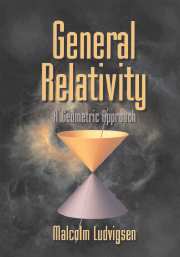Book contents
- Frontmatter
- Contents
- Preface
- PART ONE THE CONCEPT OF SPACETIME
- PART TWO FLAT SPACETIME AND SPECIAL RELATIVITY
- PART THREE CURVED SPACETIME AND GRAVITY
- 9 Curved Spacetime
- 10 Curvature and Gravity
- 11 Null Congruences
- 12 Asymptotic Flatness and Symmetries
- 13 Schwarzschild Geometries and Spacetimes
- 14 Black Holes and Singularities
- PART FOUR COSMOLOGY
- Solutions and Hints to Selected Exercises
- Bibliography
- Index
11 - Null Congruences
Published online by Cambridge University Press: 04 June 2010
- Frontmatter
- Contents
- Preface
- PART ONE THE CONCEPT OF SPACETIME
- PART TWO FLAT SPACETIME AND SPECIAL RELATIVITY
- PART THREE CURVED SPACETIME AND GRAVITY
- 9 Curved Spacetime
- 10 Curvature and Gravity
- 11 Null Congruences
- 12 Asymptotic Flatness and Symmetries
- 13 Schwarzschild Geometries and Spacetimes
- 14 Black Holes and Singularities
- PART FOUR COSMOLOGY
- Solutions and Hints to Selected Exercises
- Bibliography
- Index
Summary
In the previous section we showed that gravity, as described by the curvature tensor, exerts a converging influence on a uniform flow of inertial particles, given that energy is locally positive. This is in accord with everyday experience, in that gravity is always observed to be an attractive force. Indeed, as we have seen, this effect provides the necessary link between general relativity and Newtonian gravity. We now turn our attention to the effect gravity has on a uniform flow of massless particles, that is, a geodesic null congruence. We shall show that, even in this situation, gravity still has a converging influence. This is important, since it highlights the difference between general relativity and Newtonian gravitational theory, where light rays are unaffected by gravity. Indeed, the converging influence of gravity on light rays has led to some of the more remarkable predictions of general relativity, such as black holes and spacetime singularities.
Throughout this chapter we take la to be an affine tangent vector to a geodesic null congruence and take r to be an affine parameter such that Dr = 1, where D = la∇a.
Surface-Forming Null Congruences
A null congruence is surface-forming if its tangent vector la has the form la = ∇au for some null function u. An important example of such a congruence is that formed by future-directed null rays emanating from some timelike world line. Here the level surfaces of u will be future null cones with vertices on the world line.
- Type
- Chapter
- Information
- General RelativityA Geometric Approach, pp. 106 - 114Publisher: Cambridge University PressPrint publication year: 1999

